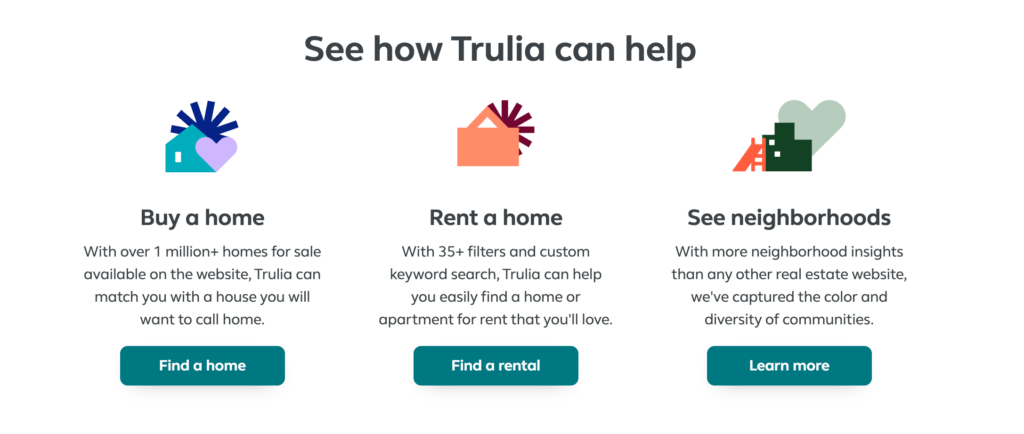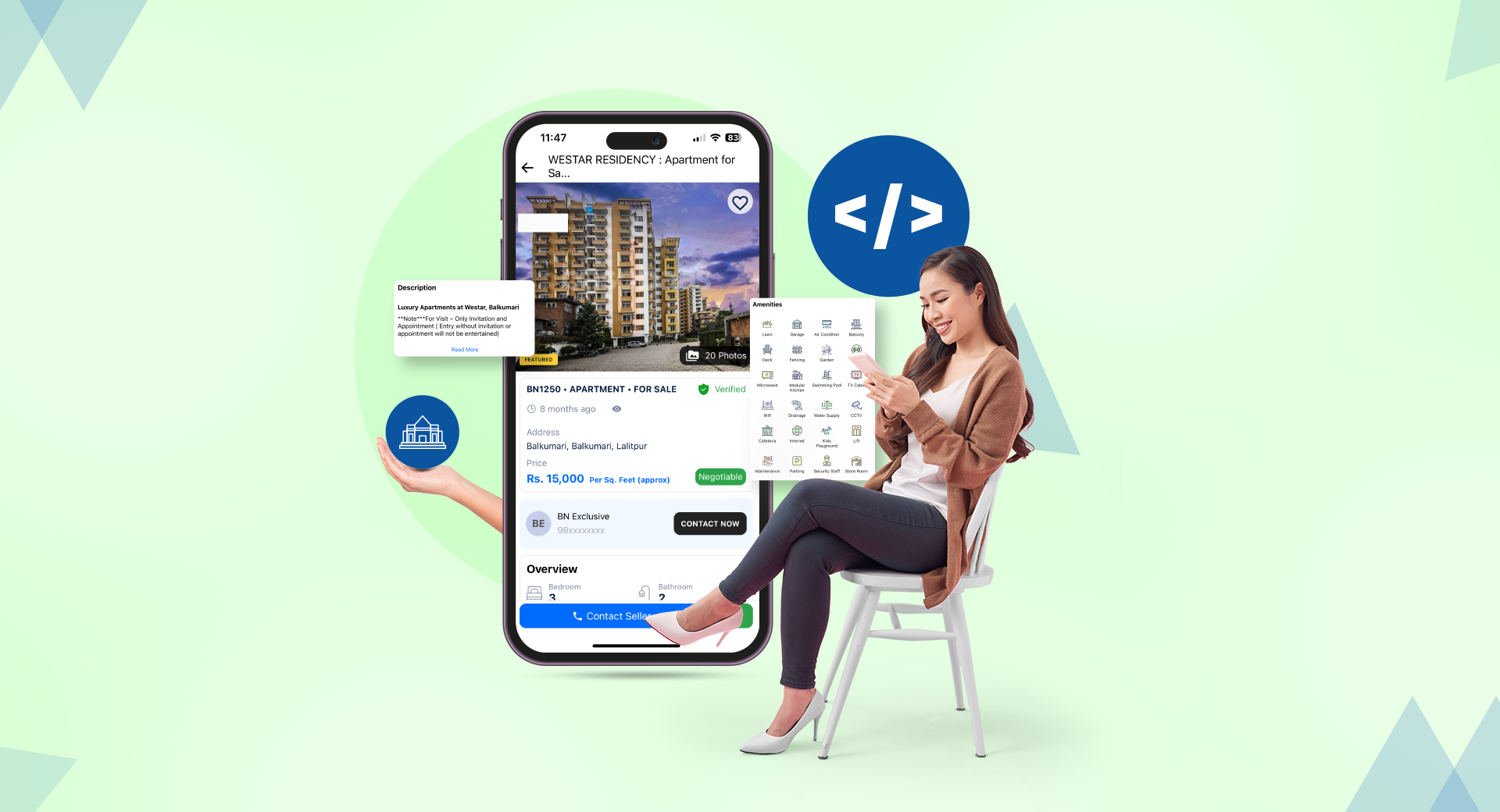Real estate mobile app development has transformed the way people experience buying and selling their properties.
With the involvement of GenZ and Millennials in the real estate business, the digitalization in the industry is inevitable. About 74% of homebuyers now use their smartphones and tablets to search properties, making real estate apps essential for staying competitive.
It’s no longer just about websites—mobile apps are key to reaching today’s buyers.
Real estate mobile app provide great convenience in searching property with features like listings, virtual tours, and geolocation, helping buyers make informed decisions quickly. For businesses, they streamline lead management, boost operational efficiency, client engagement, and streamline payment processes with tools like CRM integration and in-app communication.
However, finding a perfect mobile application with functionality that’s tailored to your needs can be difficult. There’s a noticeable gap in the real estate app market—many apps feel generic and fail to truly meet user needs.
It’s not just about having an app; it’s about creating a seamless user experience that can set you apart. With extensive experience in developing real estate applications, we understand how custom mobile apps can address internal business needs, provide solutions, and drive revenue for industry professionals.
Looking to create a real estate mobile application? Here’s is everything you need to get started:
- Types of real estate mobile app
- Key features for a real estate mobile app
- Step-by-step guide to develop real estate mobile application
- Tech Stack used to develop real estate applications
- Cost and time considerations

Types of Real Estate Mobile Applications
Real estate mobile applications may not be one-size fits all. The type of properties apps depend on your target audience and the solution you want to provide. For example: Real estate apps development can be based on whether you are looking to market your new home, or to manage your listing.
Although a custom mobile application can integrate all your business needs in one place, it’s good to know each type of real estate application that best aligns with your business.
1. Property Valuation Apps
Homebuyers and real estate professionals use property valuation apps to evaluate the worth of property before making investment decisions. Such apps gather data via algorithm to accurately estimate the market value of the property. It analyzes comparable sales, location data, and property features. For instance, Zestimate, Zillow’s home value estimator, helps users gauge if a property is priced fairly based on market trends.

2. Property Search Apps
If you want to search homes just as you search for your products online, property search apps make it happen. Property search apps enable users to browse a large database of home listings based on their criteria. The key features of this app often include search filters like price, location, size, and amenities.
The goal of such a platform is to allow users to navigate through the available options and find best suited property quickly. Platforms like Trulia help users to find properties, view photos, and even schedule viewings, all from their smartphones.

3. Real Estate Investment Apps
As more individuals look for safer investment options, real estate investment is becoming an increasingly attractive option. As many people may not afford to buy a home to become an investor, investment through real estate investment apps are gaining a user base constantly.
Real estate investment apps are designed for users looking to invest in properties, whether through direct purchases or crowd-funded platforms. The key features of these apps include – researching market trends, evaluating potential returns, and managing portfolios. For example, through Fundrise investors pool money into real estate projects, making property investment more accessible to a broader audience.

4. Mortgage Calculator Apps
Mortgage calculator apps help users estimate their monthly payments based on the price of the property, interest rates, and loan terms. Such an app makes the mortgage application process simple and easy-to-understand by offering immediate insights into affordability. You can add such features to your custom real estate mobile application to make it convenient for prospective homebuyers to process their mortgage easily.
Quicken Loans, a mortgage calculator, gives potential homeowners a clear view of their financial obligations before committing to a mortgage.
5. Property Management Apps
If you are a landlord or a property manager, property management apps can streamline and automate your day-to-day operations. The key features of such apps include rent collection, maintenance requests, financial reporting and tenant communication. It can significantly reduce your manual work and improve efficiency, offering a complete solution for your business.
Apps like Buildium or TenantCloud allow tenants to submit maintenance requests, pay rent, while allowing you to ensure smooth operations for managing multiple properties.

Essential Features for a Real Estate Mobile App
The features of the real estate mobile application depends on the types of mobile application that you are looking to build. However, here are some essential features that make a user-friendly real estate mobile application.
1. Property Listings
A comprehensive, easily accessible list of available properties allows users to quickly browse options and make informed decisions. Well-organized listings with detailed information includes images, prices, and descriptions, helping users feel confident in their choices.
2. User Profile
Real estate apps require customizable user profiles for more personalized experience, allowing users to save their preferences and personal details for more personalized experience. Profiles should also integrate saved favorites and history to track searches and favorites, streamlining future property searches
3. Signup and Login
A simple and secure signup/login process ensures users can access their profiles quickly. To encourage more users to sign up, implement social media integration or email login options.
4. Filtering Options
Filters allow users to narrow down property options based on key preferences like price, size, location, and amenities. This feature is crucial for helping users find relevant listings without overwhelming them with too many options.
5. Push Notifications
Push notifications keep users informed about new listings, price changes, or special offers. They increase engagement by providing real-time updates directly to users’ mobile devices
6. Map Integration
Map integration helps users visualize property locations and nearby amenities, making it easier to evaluate neighborhoods. It’s particularly useful for property seekers unfamiliar with the area
7. Cost Calculator
A built-in cost calculator allows users to estimate mortgage payments, taxes, and other associated costs. This feature helps users assess affordability and make better financial decisions
8. Reviews and Ratings
User reviews and ratings provide valuable insights into properties and the reliability of agents or landlords. Positive reviews help build trust and can influence purchasing or rental decisions
9. Calendar
A calendar feature allows users schedule property viewings, meetings with agents, or reminders for key deadlines. It keeps everything organized and prevents missed appointments

Desired Features for Real Estate Mobile App
The above section covered some essential features of the real estate mobile application. While those features create ready-to-use real estate apps, you can scale your application development with some advanced features. Moreover, such features can also give you a competitive edge in the industry.
| Features | Description |
| Virtual Tours & Augmented Reality | Enables users to take 3D tours of properties remotely, giving them a better sense of space and layout. This feature is crucial for remote buyers or renters and enhances user engagement. |
| Chatbot & AI Assistant | A built-in AI assistant can provide instant responses to queries, recommend properties based on user preferences, and guide users through the app, improving the overall customer experience. |
| Real-Time Availability & Booking | This feature allows users to book property viewings or schedule meetings with agents instantly, reducing delays and improving communication between clients and real estate agents. |
| Market Insights & Trends | Providing data-driven insights about neighborhood trends, property value forecasts, and market conditions can help users make informed decisions. This feature builds trust and adds value for potential investors. |
| Mortgage Pre-Approval & Financing Options | Integration with financial institutions for mortgage pre-approval or loan calculators helps streamline the purchasing process. Users can check their eligibility or receive financing options directly from the app. |
Steps to Build Real Estate Apps
Creating a real estate app needs a clear plan with specific steps that are linked together. It is important to stick to this process. This way, everything is done well, from coming up with the app idea to supporting it after it launches.
Step 1: Initial Research and Market Analysis
Before diving into development, understanding your target audience is crucial. Identify who will use your application—real estate agents, buyers, or sellers. Conduct surveys, interviews, and competitor analysis to gather insights on user preferences and pain points. For example, if you’re targeting real estate agents, focus on features that streamline their workflow, such as lead management tools or property listing integrations. Analyzing competitors can reveal gaps in the market that your app can fill, making it more appealing to users.
Step 2: UI/UX Design Considerations
Once you have a clear understanding of your audience, it’s time to focus on UI/UX design. Create a user-centric design that prioritizes ease of navigation and accessibility. Consider employing wireframes and prototypes to visualize the user journey. Features like intuitive search filters, easy property comparisons, and a clean layout can significantly enhance user experience. Remember, the goal is to make the app as engaging and straightforward as possible. Users should feel comfortable navigating through listings without feeling overwhelmed.
Step 3: Choosing the Right Technology Stack
The next step is deciding on the technology stack for your application. You have two main options: native vs. cross-platform development. Native apps (like those built for iOS or Android) offer better performance but require separate codebases for each platform. On the other hand, cross-platform frameworks like React Native or Flutter allow you to write code once and deploy it across multiple platforms, saving time and resources. Evaluate your budget, timeline, and long-term goals to make an informed decision.
Step 4: Backend Architecture and Data Security
A robust backend architecture is essential for handling user data securely and efficiently. Choose a scalable solution that can grow with your user base—consider cloud services like AWS or Google Cloud for flexibility. Additionally, prioritize data security by implementing encryption protocols and adhering to regulations like GDPR or CCPA. Users need assurance that their personal information is protected when using your app.
Step 5: Testing and Quality Assurance
Finally, don’t underestimate the importance of testing and quality assurance (QA). A thorough QA process ensures that your app is bug-free and optimized for performance before launch. Conduct various testing phases—unit testing, integration testing, and user acceptance testing—to identify any issues early on. Gathering feedback from beta testers can provide invaluable insights into usability and functionality, allowing you to make necessary adjustments.
Tech Stack to Develop Real Estate Mobile App
| Category | Technology | Description |
| Front-End | React.js, Vue.js, Angular | React.js creates dynamic and responsive user interfaces for property listings, Vue.js provides a flexible framework for building interactive property search features, whereas Angular enables the development of single-page applications for seamless user experiences |
| Back-End | Node.js, Express.js, Django | Node.js powers the server-side logic, handling requests and serving data efficiently, Express.js simplifies routing and middleware integration for managing user interactions and data flow, Django offers a robust framework for managing complex data models related to properties and users. |
| Database | PostgreSQL, MongoDB | PostgreSQL manages relational data, such as user profiles and property details, with strong integrity, MongoDB stores unstructured data like user reviews and property images in a flexible format. |
| Cloud Services | AWS, GCP | AWS provides scalable infrastructure for hosting the application and storing data securely, GCP delivers powerful tools for analytics and machine learning to enhance user experience through personalized recommendations. |
| Mobile Development | React Native, flutter | React native allows for cross-platform mobile app development, ensuring consistency across iOS and Android devices, Flutter enables the creation of visually appealing native apps with high performance from a single codebase. |
| DevOps Tools | Docker, Kubernetes | Docker streamlines deployment processes by containerizing applications, making them easier to manage across environments.Kubernetes provides containerized applications, ensuring scalability and reliability during high traffic periods. |
Cost and Time Consideration for Real Estate Mobile App Development
Developing a real estate application involves careful consideration of both cost and time. Based on insights from competitor blogs, here’s a breakdown of the key factors influencing these aspects:
Cost Considerations
- Development Team: Costs vary based on hiring freelancers, agencies, or in-house teams, with agencies typically being more expensive but offering comprehensive services.
- Features and Complexity: More features (e.g., property listings, advanced search) increase development costs. Complex functionalities like AI recommendations further raise expenses.
- Technology Stack: Choosing open-source technologies (e.g., Django, React) can help reduce costs compared to proprietary solutions.
- Design Costs: Investing in professional UI/UX design enhances user engagement but adds to the budget.
- Maintenance: Ongoing support and updates post-launch are essential and should be factored into the overall budget.
Time Considerations
- Project Scope: A basic app may take a few months to develop, while a feature-rich application could take six months or longer.
- Agile Development: Using agile methodologies can streamline the process and allow for iterative improvements, potentially reducing development time.
- Testing Phase: Allocating sufficient time for thorough testing is crucial to ensure a bug-free experience.
- Third-Party Integrations: Integrating services (e.g., payment gateways) can extend the timeline due to additional development needs.
- Regulatory Compliance: Navigating legal requirements may add time to the project as you ensure compliance with real estate regulations.
Ready to Build Your Real Estate Mobile App?
Real estate mobile applications have become indispensable tools for navigating the evolving real estate landscape.
From simplifying property searches to streamlining investment decisions and managing properties efficiently, these apps cater to diverse user needs, offering both convenience and operational efficiency.
Bonus Tip – You can consider several ways to monetize your real estate mobile application. Most popular ways to monetize your application can be to offer a subscription method to opt-in for premium features. Similarly, in- app advertising and sponsored listing can also help to drive revenue from your real estate business.
Start-off your real estate development with MVP, by incorporating essential features first. You can analyze how this solution can boost your business and then decide on scalability.
A seamless, tailored app isn’t just a luxury—it’s a necessity in today’s digital-first real estate market.
Frequently Asked Questions
A successful real estate app meets market needs. It does this by providing a smooth user experience. It includes essential features and uses new technologies. The app also changes with how consumers behave.
The time it takes to develop a real estate app depends on the project’s size, how complex it is, and the way it is developed. Usually, creating a strong real estate app can take around 6 to over 12 months.
Technical knowledge can help, but it’s not necessary. You can work with a skilled development company or use app-building platforms to make your ideas real.
The cost can vary from $40,000 to $250,000 or even more. This depends on things like how complex the app is, what features it has, which platforms it will be on, and the development method you choose.
Use strong cybersecurity steps. These include data encryption, safe user authentication, regular security checks, and following industry rules. This will help protect user data and keep your app safe.



